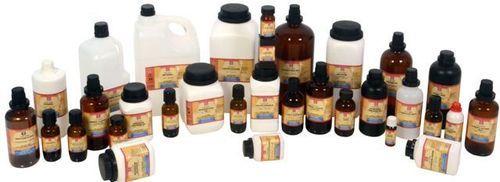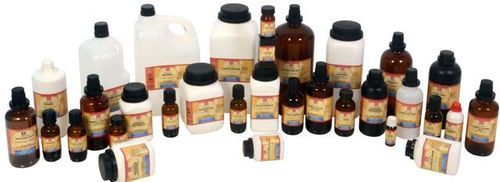एन-मिथाइल-2,2,2-ट्राइफ्लुओरोएसेटामाइड
उत्पाद विवरण:
- साइज Custom packaging available
- उपयोग Intermediate for pharmaceuticals and agrochemicals
- शेल्फ लाइफ 24 months
- पीएच लेवल Not determined
- आण्विक सूत्र C3H4F3NO
- मेल्टिंग पॉइंट Not available
- भौतिक अवस्था Liquid
- अधिक देखने के लिए क्लिक करें
X
एन-मिथाइल-2,2,2-ट्राइफ्लुओरोएसेटामाइड उत्पाद की विशेषताएं
- ग्राम प्रति घन सेंटीमीटर (g/cm3)
- 98%
- 44°C
- 141.08 g/mol
- Bottle, Drum
- Liquid
- Not available
- Pharmaceutical intermediate, chemical synthesis, organic synthesis
- 98%
- C3H4F3NO
- Not determined
- 24 months
- Custom packaging available
- Intermediate for pharmaceuticals and agrochemicals
- Colorless to pale yellow liquid
- Industrial Grade
उत्पाद वर्णन
It is used in the petrochemical and plastics industries as a solvent. Our in-depth knowledge and industrial expertise has enabled us to emerge as a reputed organization engaged in offering N-Methyl-2,2,2-trifluoroacetamide. At our sophisticated processing unit, we process this chemical using high quality compounds. Offered chemical is used in plastic, textile, petrochemical and pharmaceutical industry. To ensure safe and easy transportation, this N-Methyl-2,2,2-trifluoroacetamide is packed in quality grade glass bottles. We offer this chemical at market leading prices to clients.
Features:
- Low melting point
- Colorless liquid
- Extended shelf life
Further Details:
LC4141 N-Methyl-2,2,2-trifluoroacetamide
for synthesis
| Order number | Packaging | Quantity | Price |
| AC31141 | Glass bottle | 5 g | 26.55 |
| Product information | |
| Hill Formula | C3H4F3NO |
| HS Code | 2924 19 00 |
| EC number | 212-417-7 |
| Molar mass | 127.07 g/mol |
| CAS number | 815-06-5 |
| Chemical and physical data | |
| Melting point | 48 - 51oC |
| Molar mass | 127.07 g/mol |
| Boiling point | 156 - 157 oC (1013 hPa) |
| Flash point | 73 oC |
| Safety information | |
| R Phrase | R 36/38 Irritating to eyes and skin. |
| श्रेणियाँ of danger | irritant |
| Hazard Symbol | Irritant |
| Storage class | 10 - 13 Other liquids and solids |
| WGK | WGK 3 highly water endangering |
| Disposal | 3 Relatively unreactive organic reagents should be collected in container A. If halogenated, they should be collected in container B. For solid residues use container C. |
| Specifications | |
| Assay (GC, area%) | 98 % |
| Melting range - lower value | 48oC |
| - upper value | 51oC |
| Identity (IR) | passes test |
Versatile Chemical for Industrial Use
N-Methyl-2,2,2-trifluoroacetamide serves as a vital intermediate in the production of pharmaceuticals and agrochemicals. Its high purity and stable nature ensure optimal performance during chemical synthesis. The products compatibility with organic solvents and customizable packaging options make it suitable for diverse manufacturing and laboratory requirements.
Safe Storage and Transport
This compound remains stable when stored under recommended conditions and does not require special classification for transport. Its shelf life of 24 months allows for extended storage without compromising quality. Safe handling and storage practices ensure longevity and consistent results during application.
FAQs of N-Methyl-2,2,2-trifluoroacetamide:
Q: How should N-Methyl-2,2,2-trifluoroacetamide be stored to maintain its stability?
A: For optimal stability, store N-Methyl-2,2,2-trifluoroacetamide in tightly sealed containers at room temperature, away from direct sunlight and incompatible substances. Follow the recommended storage guidelines to preserve its 24-month shelf life.Q: What is the primary use of N-Methyl-2,2,2-trifluoroacetamide in industry?
A: This chemical is chiefly used as an intermediate in the synthesis of pharmaceuticals and agrochemicals, as well as in broader organic chemical synthesis processes.Q: When should I consider using N-Methyl-2,2,2-trifluoroacetamide in my synthesis process?
A: You should use this compound when your manufacturing or research process requires a high-purity, stable amide intermediate, particularly in pharmaceutical or agrochemical applications where precise reactivity is important.Q: Where can N-Methyl-2,2,2-trifluoroacetamide be purchased and in what packaging?
A: It is available from dealers, exporters, manufacturers, suppliers, and traders in India. Packaging options include bottles and drums, with custom sizes available to suit specific requirements.Q: What are the benefits of using N-Methyl-2,2,2-trifluoroacetamide compared to alternatives?
A: This product offers high purity (98%), chemical stability, compatibility with organic solvents, and regulatory safety due to its non-hazardous classification for transport, making it reliable for industrial and laboratory use.Q: Is special handling required during the transport of N-Methyl-2,2,2-trifluoroacetamide?
A: No special handling is required for transport as it is not regulated as dangerous goods. However, standard practices for chemical handling and storage should still be observed to ensure safety.Tell us about your requirement

Price: Â
Quantity
Select Unit
- 50
- 100
- 200
- 250
- 500
- 1000+
Additional detail
मोबाइल number
Email
Laboratory Chemicals अन्य उत्पाद
हम लैब केमिकल्स में सौदे कर रहे हैं।
“केवल 500ml तक के ऑर्डर स्वीकार करने वाले रिटेल सौदे”।
“केवल 500ml तक के ऑर्डर स्वीकार करने वाले रिटेल सौदे”।
 |
ALPHA CHEMIKA
सर्वाधिकार सुरक्षित.(उपयोग की शर्तें) इन्फोकॉम नेटवर्क प्राइवेट लिमिटेड . द्वारा विकसित एवं प्रबंधित |
 English
English Spanish
Spanish French
French German
German Italian
Italian Chinese (Simplified)
Chinese (Simplified) Japanese
Japanese Korean
Korean Arabic
Arabic Portuguese
Portuguese










